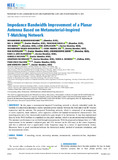Mostrar el registro sencillo del ítem
Impedance bandwidth improvement of a planar antenna based on metamaterial-inspired T-matching network
| dc.creator | Alibakhshikenari, Mohammad | es_ES |
| dc.creator | Virdee, Bal S. | es_ES |
| dc.creator | Shukla, Panchamkumar | es_ES |
| dc.creator | Wang, Yan | es_ES |
| dc.creator | Azpilicueta Fernández de las Heras, Leyre | es_ES |
| dc.creator | Naser Moghadasi, Mohammad | es_ES |
| dc.creator | See, Chan H. | es_ES |
| dc.creator | Elfergani, Issa | es_ES |
| dc.creator | Zebiri, Chemseddine | es_ES |
| dc.creator | Abd-Alhameed, Raed | es_ES |
| dc.creator | Huynen, Isabelle | es_ES |
| dc.creator | Rodriguez, Jonathan | es_ES |
| dc.creator | Denidni, Tayeb A. | es_ES |
| dc.creator | Falcone Lanas, Francisco Javier | es_ES |
| dc.creator | Limiti, Ernesto | es_ES |
| dc.date.accessioned | 2021-12-30T06:39:57Z | |
| dc.date.available | 2021-12-30T06:39:57Z | |
| dc.date.issued | 2021 | |
| dc.identifier.issn | 2169-3536 | |
| dc.identifier.uri | https://hdl.handle.net/2454/41658 | |
| dc.description.abstract | In this paper a metamaterial-inspired T-matching network is directly imbedded inside the feedline of a microstrip antenna to realize optimum power transfer between the front-end of an RF Wireless transceiver and the antenna. The proposed T-matching network, which is composed of an arrangement of series capacitor, shunt inductor, series capacitor, exhibits left-handed metamaterial characteristics. The matching network is first theoretically modelled to gain insight of its limitations. It was then implemented directly in the 50-Ω feedline to a standard circular patch antenna, which is an unconventional methodology. The antenna’s performance was verified through measurements. With the proposed technique there is 2.7 dBi improvement in the antenna’s radiation gain and 12% increase in the efficiency at the center frequency,and this is achieved over a significantly wider frequency range by a factor of approximately twenty. Moreover, there is good correlation between the theoretical model, method of moments simulation, and the measurement results. | en |
| dc.description.sponsorship | This work was supported in part by the Ministerio de Ciencia, Innovacion y Universidades, Gobierno de Espana (MCIU/AEI/FEDER,UE), under Grant RTI2018-095499-B-C31, in part by the British Council (UK-China-BRI Countries Education Partnership Initiative 2019), in part by the Innovation Programme under Grant H2020-MSCA-ITN-2016 SECRET-722424, and in part by the U.K. Engineering and Physical Sciences Research Council (EPSRC) under Grant EP/E022936/1. | en |
| dc.format.extent | 12 p. | |
| dc.format.mimetype | application/pdf | en |
| dc.language.iso | eng | en |
| dc.publisher | Institute of Electrical and Electronics Engineers Inc. | en |
| dc.relation.ispartof | Ieee Access, 9, 67916-67927 | en |
| dc.rights | Creative Commons Attribution 4.0 International | en |
| dc.rights.uri | http://creativecommons.org/licenses/by/4.0/ | |
| dc.subject | T -matching circuit | en |
| dc.subject | Microstrip antenna | en |
| dc.subject | Metamaterial | en |
| dc.subject | Transmission-line | en |
| dc.subject | Impedance matching._x000D_ | en |
| dc.title | Impedance bandwidth improvement of a planar antenna based on metamaterial-inspired T-matching network | en |
| dc.type | Artículo / Artikulua | es |
| dc.type | info:eu-repo/semantics/article | en |
| dc.contributor.department | Institute of Smart Cities - ISC | es_ES |
| dc.contributor.department | Ingeniería Eléctrica, Electrónica y de Comunicación | es_ES |
| dc.contributor.department | Ingeniaritza Elektrikoa, Elektronikoa eta Telekomunikazio Ingeniaritza | eu |
| dc.rights.accessRights | info:eu-repo/semantics/openAccess | en |
| dc.rights.accessRights | Acceso abierto / Sarbide irekia | es |
| dc.identifier.doi | 10.1109/ACCESS.2021.3076975 | |
| dc.relation.projectID | info:eu-repo/grantAgreement/AEI/Plan Estatal de Investigación Científica y Técnica y de Innovación 2017-2020/RTI2018-095499-B-C31/ES/ | en |
| dc.relation.projectID | info:eu-repo/grantAgreement/European Commission/Horizon 2020 Framework Programme/722424 | en |
| dc.relation.publisherversion | http://doi.org/10.1109/ACCESS.2021.3076975 | |
| dc.type.version | info:eu-repo/semantics/publishedVersion | en |
| dc.type.version | Versión publicada / Argitaratu den bertsioa | es |



